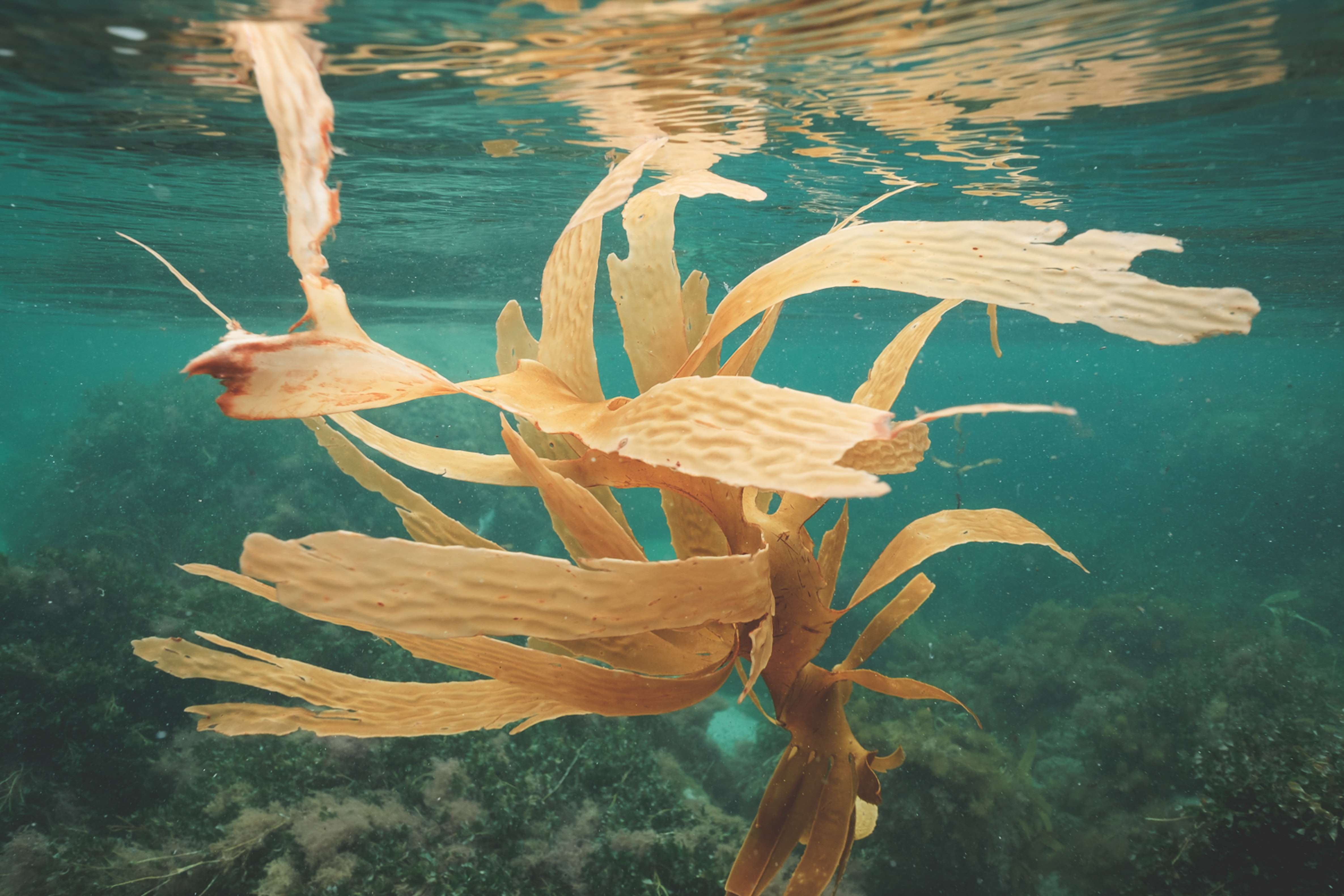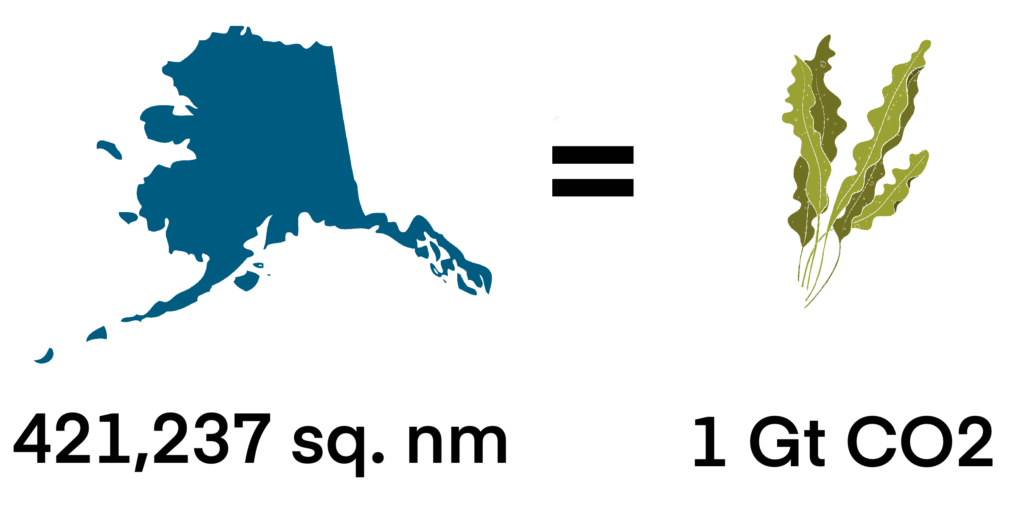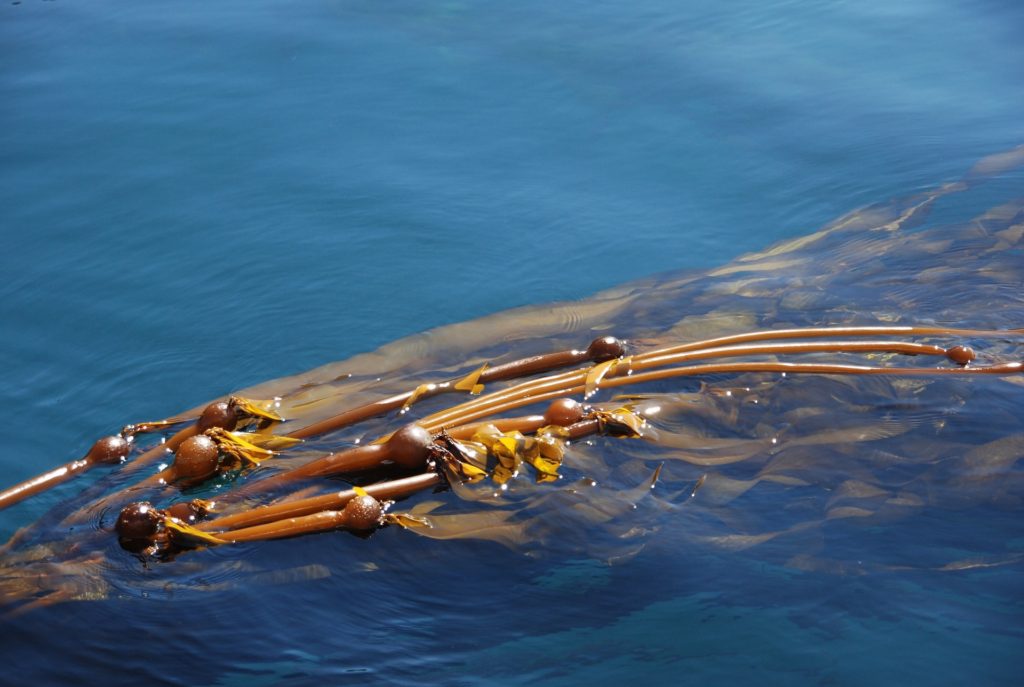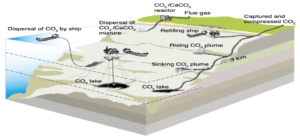Nature-based or natural climate solutions involve managing ecosystems to respond to climate change [1]. One strategy with increasing buzz is macroalgae aquaculture and restoration. Or, growing seaweed to save the world. While this may sound far-fetched, seaweeds have a lot going for them.
Macroalgae, such as kelp, perform photosynthesis, meaning they store carbon dioxide and produce oxygen as they grow just like trees on land. At large enough scales macroalgae could sequester a significant amount of carbon dioxide from the atmosphere, limiting the greenhouse effect behind global heating.
Macroalgae may also mitigate ocean acidification [2] and pollution by producing oxygen and absorbing heavy metals from seawater [3]. Additional co-benefits include shoreline protection and new materials for biofuels, fertilizer, and pharmaceuticals [4]. Not to mention a nutritional food source that’s high in carbs and proteins.

It also doesn’t hurt that seaweeds make for efficient harvests. Seaweeds are among the fastest-growing plants on the planet, some species grow a half-meter per day! And since sunlight and nutrients are readily available in the water column, no fertilizer is necessary. Given some ropes to hang from, macroalgae have everything they need.
But don’t get too excited. While macroalgae have an established $13.3 billion market [3] – that made up 27% of total aquaculture production in 2017 – scientists have only recently begun to study seaweed as a means of large-scale carbon dioxide removal (CDR) [5]. Since this idea is still in its nascent stage, there’s plenty of uncertainty as to the broader environmental effects, the amount of seaweed necessary to make a dent in global warming, and whether macroalgae CDR is feasible.
This article tries to answer some of these questions and get you up to speed on how macroalgae might help save the world.
Setting up your first seaweed farm
Let’s pretend that President Biden has given you the greenlight to cultivate as much macroalgae as you want. Where do you put your farm? How much space do you need?
Macroalgae prefer cold, nutrient-rich waters, which typically coincide with upwelling zones – where deep water with high amounts of biological material rises to the surface [6]. In part, this trend explains why Maine and Alaska are leading the U.S. kelp industry [9].
However, it’s possible that macroalgae farms could deplete nutrient-rich waters over time, limiting growth. In that case, it’s been suggested that hydro-powered upwellers could artificially circulate a reliable supply of nutrients [3]. Genetically modifying seaweeds (or their symbionts) to access nutrients more efficiently is another potential solution [10].
Location is simple enough, but the question of scale is where things get out of hand. A ton of mature macroalgae sequesters roughly one ton of carbon dioxide [3]. Capturing one gigaton (Gt) of carbon dioxide, roughly equivalent to the annual emissions of the global maritime industry, would require between 70,270 square nautical miles (nm2) and 421,237 nm2 [3]. That’s about the size of Oregon or, on the high end, Alaska.

That’s a lot of space turned over to seaweed cultivation, and frankly it would not put much of a dent in global heating by itself. The Intergovernmental Panel on Climate Change projects that carbon capture and storage (CCS) needs to sequester 220-2200 Gt of carbon dioxide to limit warming to 1.5ºC [11]. Meeting that figure with macroalgae CDR could require an area greater than every country’s exclusive economic zone combined [3].
So realistically, seaweeds cannot save the world on their own, but that’s not the industry’s goal. Macroalgae can still play a role in the larger carbon sequestration project, right?
Hold onto your carbon
So far, we’ve assumed that macroalgae permanently store all the carbon they sequester from the atmosphere. In reality, the story is more complicated.
For a long time, macroalgae were not understood as a carbon sink. Scientists believed that the carbon stored inside macroalgae was re-released into the atmosphere once seaweeds began to decompose. While recent reports [6] indicate that macroalgae store more carbon than previously thought, this topic remains controversial [12].
The question is, where does seaweed go after it starts to break down? If it stays near the surface, then it will likely release its sequestered carbon too quickly and be an ineffective carbon sink. If it sinks, then it could reliably store carbon in deep sea sediments over a long, geologic time frame. The sink/float uncertainty likely depends on a number of factors, including ocean depth and currents.

Scientists are now trying to answer this question by measuring macroalgae DNA in sediment as a proxy for macroalgae sinking and, thus, carbon storage [13]. A 2019 study estimated that 24% of the carbon macroalgae sequester in surface waters is stored in the deep sea [12]. Of course, this inquiry applies to wild, not farmed seaweed.
It is more difficult to track the fate of stored carbon after seaweeds are consumed or converted into pharmaceuticals and fertilizers[14]. Measuring carbon capture (or loss) throughout the lifecycle of macroalgae products is new territory for scientists and researchers.
The best way to ensure that the carbon in seaweed stays out of the atmosphere is to attach weights to it and sink it [15]. But this approach would mean foregoing the products associated with macroalgae cultivation, and it would be more expensive. Plus, the environmental effects of sinking large amounts of seaweed into deep sea ecosystems are unknown [2].
Warming, warming, gone
We have to consider that seaweeds are vulnerable to ocean heating, the phenomenon they are meant to address. As waters continue to warm, macroalgae could become less effective carbon sinks.
Take the kelp forests of the fast-warming Gulf of Maine. When water temperatures exceed 65ºF, kelp growth is limited, and its fronds fall apart. Since the 1980s, the number of days surpassing that threshold have increased by 40x in certain locations off the Maine coast [16]. Over the same period, kelp’s historic range has declined by 80% [17].
While kelp forests struggle to adapt, other species are thriving in the warmer waters. In the Gulf of Maine, shrubby seaweeds are outcompeting (i.e., replacing) kelp. Invertebrates that favor warm water are also growing on kelp, limiting its development and carbon storage potential [17].
But even in the face of warming, there is still hope for macroalgae [18]. It’s possible that genetic engineering could make seaweed more resistant to warming [3]. Some species might already have innately higher heat tolerances than others [19]. So while ocean warming appears to be a legitimate concern for macroalgae CDR, specific species and strategies might prevail.
Seeding the waters
Seaweeds have value as a means for carbon storage and for other services, as well. But many questions remain. Macroalgae CDR is an under-studied topic, and studies on farmed or restored seaweed – rather than wild assemblages – are even newer.
Still, the answers won’t come by doing nothing. So far, Asia leads the global seaweed industry, though the region’s focus is on food, not climate change mitigation. The U.S. government [3] and private sector have recently started pursuing seaweeds and carbon storage. While many facets of macroalgae CDR are uncertain, there are plenty more reasons to go for it.
References
[1] “What are Nature-Based Solutions?” American University
[2] Wood, Daniel, et al. “UK macroalgae aquaculture: What are the key environmental and licensing considerations?” Marine Policy, vol. 83, Sept. 2017, pp. 29-39, doi:10.1016/j.marpol.2017.05.021.
[3] Von Keitz, Marc. “State of macroalgae science and technology.” Ocean Visions Macroalgae Cultivation Workshop, 15 Oct. 2020. Lecture.
[5] Duarte, Carlos M., et al. “Can Seaweed Farming Play a Role in Climate Change Mitigation and Adaptation?” Frontiers in Marine Science, vol. 4, Apr. 2017, pp. 1-8, doi:10.3389/fmars.2017.00100.
[6] University of Western Australia. “Role of kelp forests in mitigating climate change under threat.” PHYS ORG, 4 June 2018, .
[7] Gershenson, Gabriella. “‘I’m not a quitter’: lobstermen turn to kelp farming in the face of climate crisis.” The Guardian, 19 May 2020.
[8] Stopha, Mark. “Alaska Kelp Farming The Blue Revolution.” Alaska Fish and Wildlife News, Apr. 2020.
[9] Held, Lisa Elaine. “Kelp Is Not the New Kale; It’s a Crop With Bigger Challenges, and Possibilities.” Food Print, 1 June 2020.
[10] Carrington, Damian. “GM microbe breakthrough paves way for large-scale seaweed farming for biofuels.” The Guardian.
[11] Metz, Bert, et al., editors. Carbon Dioxide Capture and Storage. Cambridge University Press, 2005. IPCC.
[12] Ortega, Alejandra, et al. “Important contribution of macroalgae to oceanic carbon sequestration.” Nature Geoscience, vol. 12, Aug. 2019, pp. 748-54, doi:10.1038/s41561-019-0421-8.
[13] Ortega, Alejandra, et al. “Environmental DNA identifies marine macrophyte contributions to Blue Carbon sediments.” Limnology & Oceanography, vol. 65, Aug. 2020, pp. 3139-49, doi:10.1002/lno.11579.
[14] Laurens, Lieve M.L, et al. “Sustainable Seaweed Biotechnology Solutions for Carbon Capture, Composition, and Deconstruction.” Trends in Biotechnology, vol.38, May 2020, pp. 1232-44, doi:10.1016/j.tibtech.2020.03.015.
[15] Woody, Todd. “Seaweed ‘forests’ can help fight climate change.” National Geographic, 29 Aug. 2019.
[16] Dijkstra, Jennifer A., et al. “Temperature, phenology, and turf macroalgae drive seascape change: Connections to mid‐trophic level species.” Ecosphere, vol. 10, Nov. 2019, p. e02923, doi:10.1002/ecs2.2923.
[17] Woodard, Colin. “Kelp, the forests of the sea, vanishing from southern Maine as Gulf warms.” Portland Press Herald, 16 Nov. 2019.
[18] Kimbrough, Liz. “The kelps are alright: Studies reveal resilience in kelp forests.” Mongabay, Apr. 2020, .
[19] Hamilton, Sara L., et al. “Remote sensing: generation of long‐term kelp bed data sets for evaluation of impacts of climatic variation.” Ecology, vol. 28, Feb.2020, doi:10.1002/ecy.3031.


